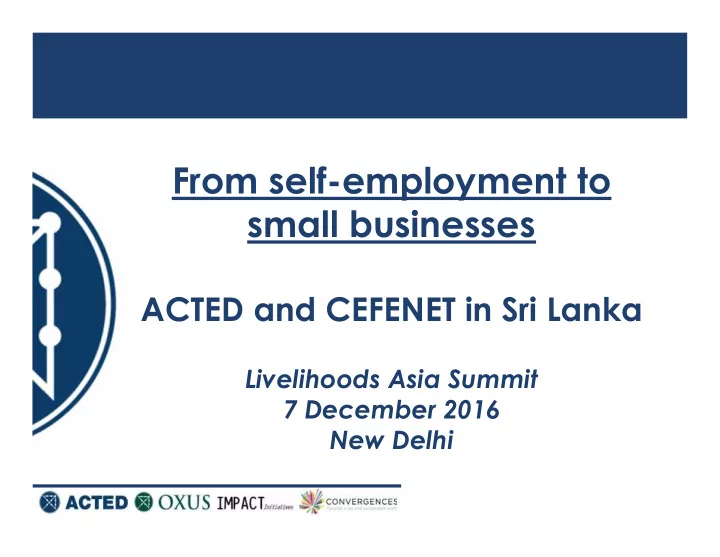

From self-employment to small businesses ACTED and CEFENET in Sri Lanka Livelihoods Asia Summit 7 December 2016 New Delhi
Introduction Project title Community-driven development and pro-poor economic growth for conflict-affected population in Northern and Eastern Sri Lanka Partners Period • ACTED From 2012 to 2014 • Competency-based Economies through Formation of Enterprise Donor (CEFE-NET) • Centre for Poverty Analysis (CEPA) European Union 2
Self-employment and beyond Objective Supporting self-employed individuals in rural Sri Lanka to become micro, small and medium enterprises (MSMEs). Achievements Increase of income through improvement of products and marketing Creation of employment opportunities for youth in rural parts of Sri Lanka reduction of poverty. 3
Background MSMEs in Sri Lanka • 90 % all businesses in Sri Lanka are MSMEs • Essential source of employment opportunities: contribute about 35% of employment • Create opportunities to use local resources • Galvanise the development of the rural economy • Contribute to social integration in the country 4
Methodology/Action plan 1. Market study to understand the competent value chains for upgrading in target areas 2. Identification and selection of the self-employed individuals to become MSMEs. 3. Diagnostic study to understand the gaps for further improvement of self-employed entrepreneurs 4. Business planning workshops to develop individual business plans for upgrading to MSMEs 5. Counseling in business plan implementation 5
Methodology/Action plan (cont.) 6. Capacity-building : development of entrepreneurial, technical and business management capacities 7. Provision of assets + technology transfers for better and improved production 8. Marketing support : linking rural entrepreneurs with major city markets; buyer-seller meetings; trade fairs at local and national level; linkage with national level exporters for MSMEs with products suitable for exportation. 6
Step 1: Market study Comprehensive market study to understand the competent value chains in target areas. 7
Step 2: Identification of self- employed individuals A. Development of criteria for identification and selection of suitable self-employed individuals to be supported. Examples of criteria: already self-employed, potential for value additions, market demand, beneficiary’s contribution towards investment, utilization of local raw material 8
Step 2 (cont.) B. Call for expression of interest from interested self- employed individuals in the target sectors C. Selection of beneficiaries : competitive process, with Local Chamber of Commerce, CEFENET Sri Lanka and ACTED as jury 9
Step 3: Diagnostic study Purpose Understanding the needs and potential for further improvement of selected beneficiaries. Examples Gaps in marketing, production, management, human resources and finance Issues in investment for expansion of operations, business registration, environment pollution , labour laws and regulations Potential for further development of the operation Requirements in technical training and management training Requirements in infrastructure facilities such as tools, machinery and equipment Business counseling needs for MSMEs to grow 10
Steps 4/5: Business planning/Business plan implementation Workshop to develop a business plan. The business plan serves to: • Identify potential areas of investment • Identify and select assets Content of a business plan: • Marketing plan • Production or technical plan • Organization and Management plan • Financial plan 11
Step 6: Capacity building Training and counseling on: Participation in buyer-seller forums + • entrepreneurship, trade fairs. • marketing, • finance, Development of • management, linkages with BDS, • product development, financial institutions, buyers and suppliers. • brand development, • packaging and labeling, • quality assurance, • cleaner production, • equal employment opportunities, • risk assessment and management. 12
Step 7: Conditional provision of assets and technology transfer Based on the needs identified, beneficiaries were provided with: required assets for improved and cleaner production; • necessary technology transfers. • But under the following conditions: Creation of at least one employment opportunity for • each 300,000 LKR worth of assistance provided; Ensure the capability of MSMEs to manage the assets; • Beneficiary’s contribution of 15% for investment in new • assets. 13
Step 8: Marketing support for MSMEs Marketing interventions to support the MSMEs in marketing their products and services. Examples: • Linking rural entrepreneurs with major city markets. • Organizing buyer-seller meetings, and encouraging participation in local and national level trade fairs. • Linking MSMEs selling products suitable for export with national level exporters. 14
Similar interventions in Sri Lanka Among others, UNDP, GIZ, UNIDO and OXFAM implemented projects to encourage self-employed individuals to become MSMEs. • Creating an enabling environment for self-employed individuals to become MSMEs – Development of a MSME policy for government approval. • Development of the BDS capacity in the regions in order to ensure the sustainability of BDS delivery. • Training of Trainers and business counselors in MSME development for government, private and some NGOs working in the field of MSME development. • Introducing entrepreneurship to vocational and technical Training institutes • Revolving fund for micro and small enterprises’ financial needs 15
Development of female-owned MSMEs In 2010-2014, the Government of Sri Lanka implemented a special MSME development programme for women entrepreneurs in the country. Special loan scheme for women entrepreneurs up to 250,000 LKR without interest, to be paid back within 5 years; Women-only financials schemes available through state banks at reduced rate of interest of 4% per annum, for loans up to 0.5 million. 16
SME policy To create an enabling environment, a SME policy was drafted by GIZ/NEDA/Business Chambers, with support from CEFENET; and presented to the government for approval. The policy addresses: individual entrepreneurial capacity; access to technology; access to finance; access to BDS at regional level; business counseling services. 17
Thank you!
Recommend
More recommend